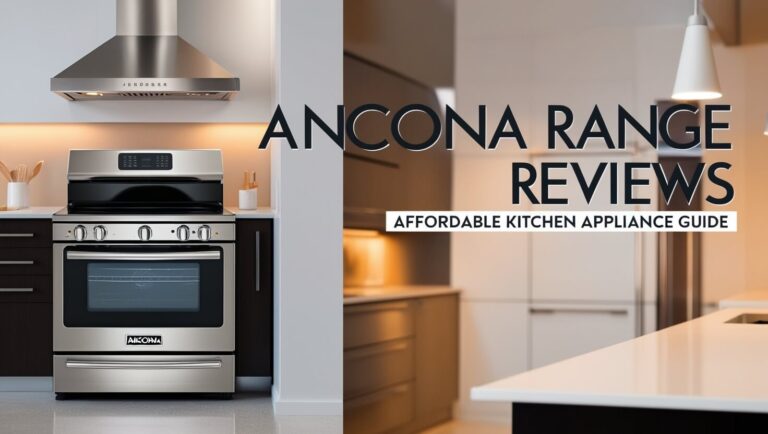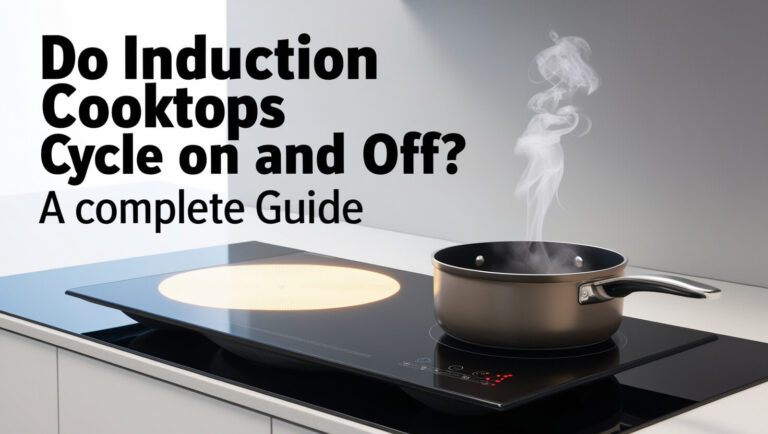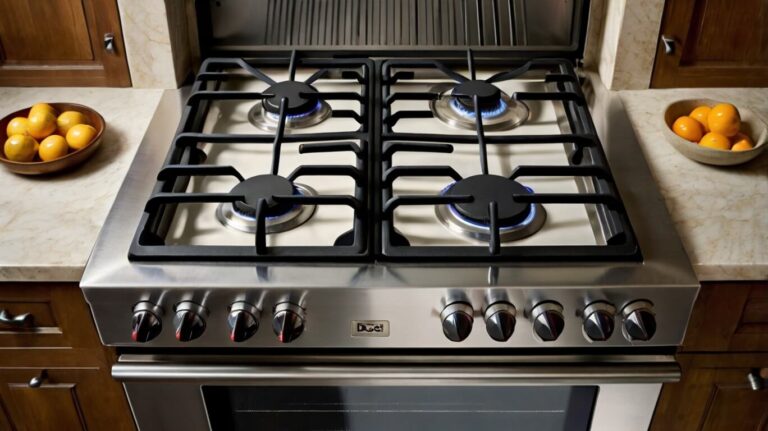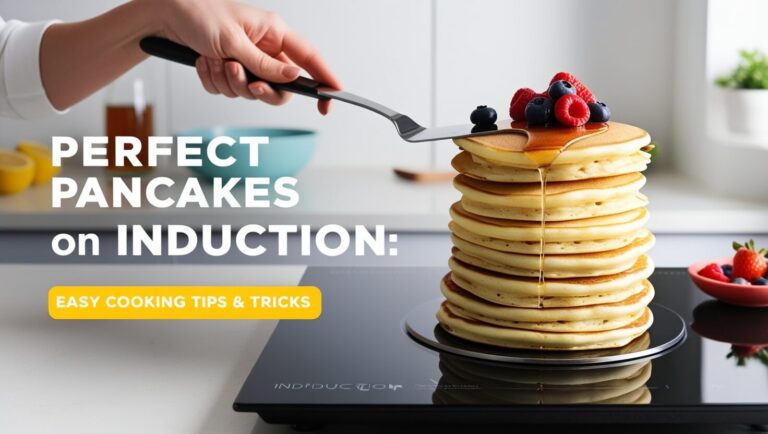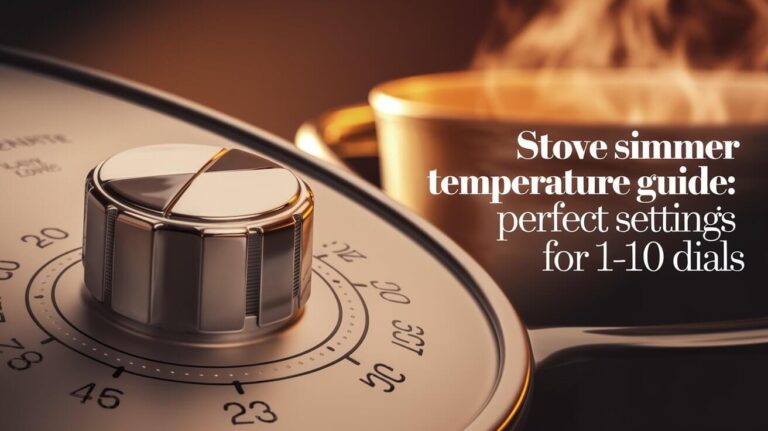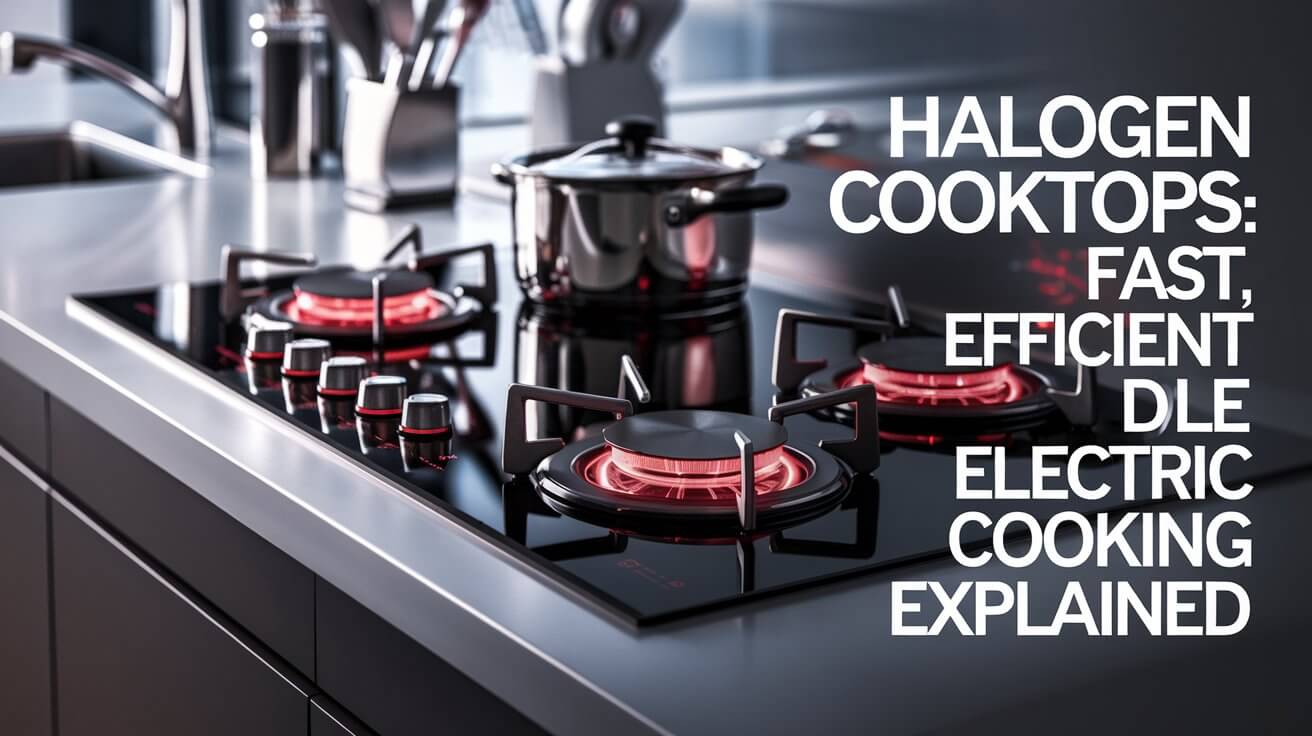
A halogen cooktop is an innovative kitchen appliance that uses halogen bulbs to generate heat for cooking. These sleek, flat-surfaced cooking units offer rapid heating, precise temperature control, and energy efficiency. In this comprehensive guide, we’ll explore the ins and outs of halogen cooktops, their benefits, and how they stack up against other cooking technologies.
Basics of Halogen Cooktops
Halogen cooktops have gained popularity in recent years due to their unique heating method and stylish appearance. Let’s dive into how these modern cooking marvels work and what sets them apart from traditional stovetops.
How Halogen Cooktops Work
At the heart of a halogen cooktop lies a set of powerful halogen bulbs. These bulbs emit infrared radiation when electricity passes through them. The radiation quickly heats the glass-ceramic surface above, which then transfers heat to your cookware.
This process happens incredibly fast. When you turn on a halogen cooktop, you’ll see a bright red glow from the bulbs beneath the surface. This visual indicator not only looks cool but also helps you gauge the heat level at a glance.
Key Components of a Halogen Cooktop
- Halogen bulbs: These are the workhorses of the cooktop, generating intense heat through infrared radiation.
- Glass-ceramic surface: This smooth, flat top allows for easy cleaning and even heat distribution.
- Reflective tray: Located beneath the bulbs, it helps direct heat upwards for maximum efficiency.
- Control panel: Usually touch-sensitive or knob-operated, it allows you to adjust heat settings precisely.
- Safety sensors: These monitor temperature and automatically shut off the cooktop if it overheats.
Advantages of Halogen Cooktops
Halogen cooktops bring several benefits to the table, making them a favorite among home cooks and professional chefs alike.
Rapid Heating and Cooling
One of the standout features of halogen cooktops is their lightning-fast heating capability. Unlike traditional electric coils that take time to warm up, halogen bulbs reach full power almost instantly. This means less waiting around for your pan to heat up and more time actually cooking.
Equally impressive is how quickly halogen cooktops cool down. Once you turn off the heat, the cooking zone temperature drops rapidly, reducing the risk of accidental burns.
Energy Efficiency
Halogen cooktops are designed to be energy-efficient. They direct heat straight to the cookware, minimizing energy waste. While not as efficient as induction cooktops, they still outperform many traditional electric models.
Precise Temperature Control
With halogen cooktops, you get granular control over your cooking temperature. Most models offer multiple heat settings, allowing you to fine-tune the heat for perfect results whether you’re simmering a delicate sauce or searing a steak.
Safety Features
Many halogen cooktops come equipped with built-in safety features. These may include:
- Automatic shut-off if the cooktop overheats
- Child lock functions to prevent accidental activation
- Residual heat indicators that warn you when the surface is still hot
Comparing Halogen Cooktops to Other Types
To fully appreciate halogen cooktops, it’s helpful to see how they measure up against other common cooking technologies.
Halogen vs. Electric Coil Cooktops
Halogen cooktops offer several advantages over traditional electric coil models:
- Faster heating and cooling
- Easier to clean due to the flat surface
- More precise temperature control
- Sleeker appearance
However, electric coil cooktops are generally less expensive upfront.
Halogen vs. Ceramic Cooktops
While both feature a smooth, glass-like surface, halogen cooktops heat up and cool down faster than ceramic models. Ceramic cooktops, however, tend to be more affordable and may retain heat longer, which can be beneficial for keeping food warm.
Halogen vs. Induction Cooktops
Induction cooktops are often considered the gold standard in modern cooking technology. They use electromagnetic fields to heat cookware directly, making them more energy-efficient than halogen models. However, halogen cooktops work with all types of cookware, while induction requires special magnetic-based pots and pans.
Halogen vs. Gas Cooktops
Gas cooktops offer instant heat control and are favored by many professional chefs. Halogen cooktops can’t match the visual feedback of a gas flame, but they’re generally safer, easier to clean, and don’t require a gas line installation.
Choosing the Right Cookware for Halogen Cooktops
To get the most out of your halogen cooktop, it’s crucial to use the right cookware.
Compatible Materials
Halogen cooktops work well with a wide range of materials, including:
- Stainless steel
- Cast iron
- Copper
- Aluminum
- Ceramic
- Glass
This versatility is a significant advantage over induction cooktops, which require magnetic-based cookware.
Optimal Pot and Pan Shapes
For best results, use cookware with:
- Flat bottoms: This ensures maximum contact with the cooking surface for even heat distribution.
- Thick bases: Heavier pots and pans help distribute heat more evenly and prevent hot spots.
- Sizes that match the cooking zones: Using appropriately sized cookware improves efficiency and prevents energy waste.
Installation and Maintenance of Halogen Cooktops
Proper installation and maintenance are key to getting the most out of your halogen cooktop.
Installation Process
While it’s best to have a professional install your halogen cooktop, the process is generally straightforward:
- Measure and cut the countertop to fit the cooktop
- Connect the cooktop to the power supply
- Secure the cooktop in place
- Test all functions to ensure proper operation
Cleaning and Care Tips
Keeping your halogen cooktop clean is easy thanks to its smooth surface:
- Let the cooktop cool completely before cleaning
- Use a soft cloth or sponge with mild detergent and warm water
- For tough stains, use a specialized ceramic cooktop cleaner
- Avoid abrasive cleaners or scrubbers that could scratch the surface
- Wipe the cooktop dry after cleaning to prevent water spots
Troubleshooting Common Issues
Some common problems with halogen cooktops include:
- Burners not heating: Check the power connection and fuse
- Uneven heating: Ensure you’re using flat-bottomed cookware
- Scratched surface: Use gentler cleaning methods and avoid sliding pots and pans across the cooktop
Cooking with a Halogen Cooktop
Mastering your halogen cooktop can take your culinary skills to new heights.
Adjusting to Halogen Cooking
If you’re switching from another type of cooktop, you might need to adjust your cooking techniques:
- Start with lower heat settings than you’re used to, as halogen cooktops heat up quickly
- Use the visual cues (red glow) to gauge heat levels
- Take advantage of the precise temperature control for delicate dishes
Best Dishes for Halogen Cooktops
Halogen cooktops excel at:
- Stir-frying: The quick heat response is perfect for high-heat, fast cooking
- Searing meats: Achieve a perfect crust with the intense, direct heat
- Simmering sauces: Use the precise temperature control for gentle cooking
Tips for Optimal Performance
To get the most out of your halogen cooktop:
- Preheat pans for even cooking
- Use lids to trap heat and cook more efficiently
- Clean spills promptly to prevent staining or burning onto the surface
Environmental Impact of Halogen Cooktops
As we become more environmentally conscious, it’s important to consider the eco-friendliness of our appliances.
Energy Consumption
Halogen cooktops are more energy-efficient than traditional electric coil models but less so than induction cooktops. They use about 90% of their energy for cooking, with only 10% lost as visible light.
Lifespan and Disposal
Halogen bulbs typically last several years before needing replacement. When disposing of old cooktops or bulbs, check with your local waste management facility for proper recycling options.
Cost Considerations for Halogen Cooktops
When shopping for a halogen cooktop, it’s important to consider both upfront and long-term costs.
Initial Investment
Halogen cooktops generally fall in the mid-range price bracket:
- More expensive than basic electric coil models
- Less expensive than most induction cooktops
- Comparable to mid-range gas cooktops
Prices can vary widely based on brand, size, and features.
Long-term Operating Costs
While the initial cost might be higher than some alternatives, halogen cooktops can save money in the long run:
- Lower energy bills compared to traditional electric cooktops
- Minimal maintenance costs due to simple design
- Long lifespan with proper care
The Future of Halogen Cooktop Technology
As kitchen technology continues to evolve, what’s next for halogen cooktops?
Innovations on the Horizon
Future halogen cooktops might feature:
- Smart connectivity for remote control and monitoring
- Improved energy efficiency through advanced materials
- Integration with other kitchen appliances for seamless cooking experiences
Market Trends
While induction technology is gaining ground, halogen cooktops continue to hold a significant market share due to their reliability, ease of use, and compatibility with all cookware types.
Halogen cooktops offer a compelling blend of performance, efficiency, and style for modern kitchens. Whether you’re a seasoned chef or a cooking novice, these versatile appliances can elevate your culinary experience. By understanding their strengths and how to use them effectively, you can make the most of this innovative cooking technology.

